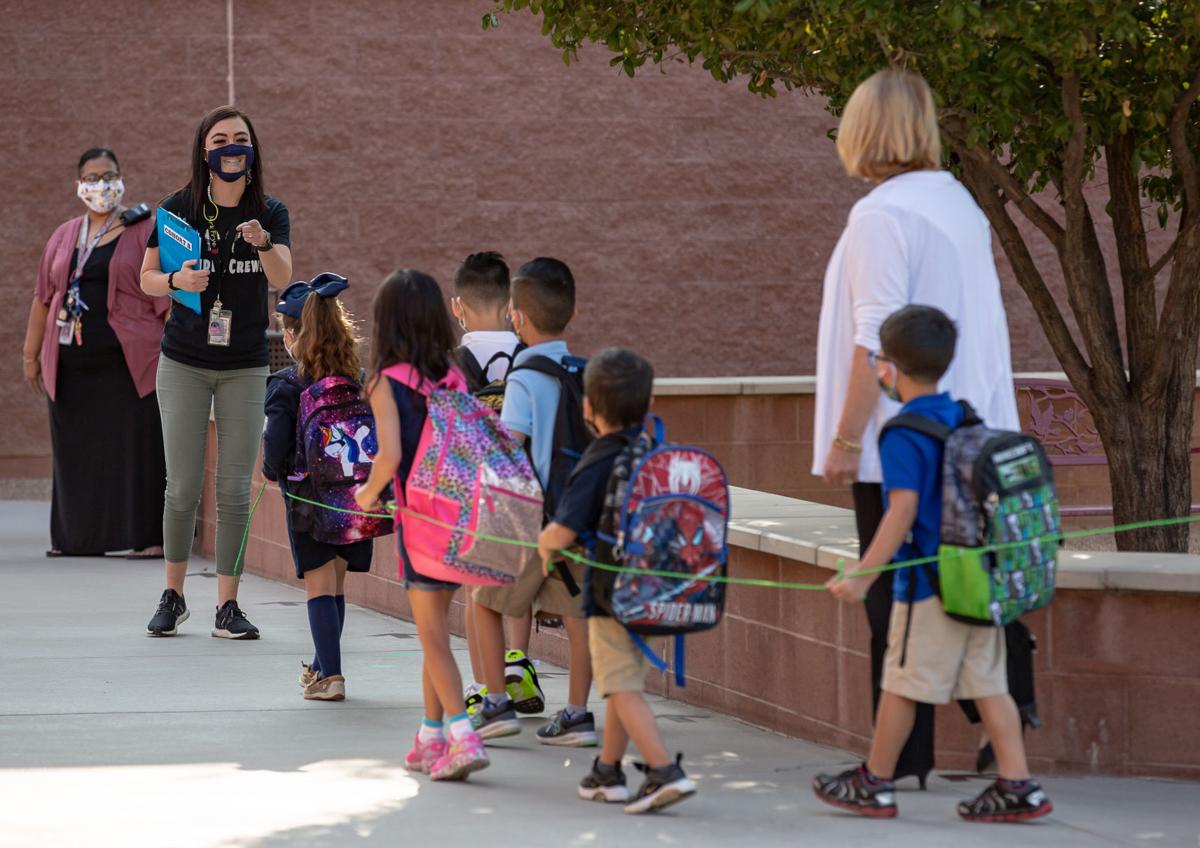An average 20% boost in Arizona teacher salaries in the past four years has apparently done little to entice people into the classroom and keep experienced staffers there.
And that’s only being complicated as hundreds of teachers walk away — some for good — because of COVID-19 risks.
Schools recently surveyed were able to fill just 28% of the vacancies they had due to retirement and other reasons that teachers left their jobs, said a new report Thursday from the Arizona School Personnel Administrators Association.
Districts had to make up the difference largely by having returning teachers work extra hours or by using long-term substitutes.
Filling vacancies has been a perennial problem in Arizona schools, noted Justin Wing, immediate past president of the Arizona School Personnel Administrators Association.
This video offers some pros and cons of online education, as many schools and universities have suspended in-person classes due to the spread of the coronavirus.
But Wing said there’s something different in this year’s report: the number of experienced teachers who resigned as the school year began.
In normal years, there always are new teachers who quickly conclude the job isn’t what they expected and decide to pursue another career, Wing said. This year, he said, the problem appears to be directly related to COVID-19.
The 145 school districts and charter schools that responded to the survey reported 751 teachers leaving at the beginning of the year.
Of those resignations, 326 were by teachers who said they were quitting outright or retiring while citing the coronavirus as the prime reason. And an additional 342 teachers said they were taking a year off, without pay, due to COVID-19.
The districts also reported 633 other nonteaching staff members who resigned or retired citing the virus as the primary reason.
Salaries also remain an issue, Wing said.
“Even though pay has gone up, we were in a big hole,” he said.
Facing a teacher walkout in 2018, Gov. Doug Ducey pushed through funding designed to provide a 20% average pay increase over four years. This is the final year of that increase.
That did not mean all teachers are getting that much more, with variables including what teachers were making before and how district officials chose to allocate those dollars.
It helped, Wing said, but only to a point, adding, “We’re still bottom five in average salaries.”
There are other issues, too, Wing said: “The main one is, why are high school kids not going into the teaching profession?”
He acknowledged that state lawmakers altered requirements to become a teacher, allowing people to make mid-career switches without having to go back to school for a full-blown education degree. And he said that has been important: “I don’t know what we’d do without that.”
But he said the solution will have to come from getting more people into the profession right out of college.
One problem , he said, is that Arizona has one of the highest student-to-teacher ratios in the country.
“Kids see that,” a situation that hasn’t changed in the 12 years that high school seniors have been in public school classes.
“They’re seeing that the teacher’s not able to emphasize on each individual because of that high class size,” Wing continued. “They see the stresses and the toll that takes on a teacher.”
State schools chief Kathy Hoffman said the results of the annual survey “are startlingly but not altogether shocking for the education community.”
She, too, has seen the impact of COVID-19.
“Some educators make the difficult decision to leave the classroom,” Hoffman said in a prepared statement. “I know this decision is deeply personal to each educator. And I hope that one day we can recruit them back to our schools.”
Hoffman cited the work of her agency’s Educator Recruitment and Retention Team, which she formed last November. Aides to Hoffman said it is designed to function as a hub of information about what has worked at some schools to keep teachers in the classroom as well as to provide help to other schools having challenges.
There was no immediate response from Ducey to the teacher-shortage report.
Photos: Back-to-school in Tucson during the pandemic
"Mustang Stampede"
Updated
Maddy Jacobs, 7, middle, reaches for her remote learning tool kit from her teacher, Kris Green, as her friend, Carly Kupinski, 6, watches during a "Mustang Stampede" at Manzanita Elementary School for the first day of school on August 17, 2020.
First Day of School, John B. Wright Elementary
Updated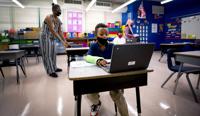
Augusta Iranzi, center, attends his teachers online class while monitors Jasmine Phillip, left, and Nadifo Yusuf, watch students inside a classroom at John B. Wright Elementary School, 4311 E. Linden St., in Tucson, Ariz. on August 17, 2020. About 10 students came to school for online instruction under the guidance of classroom monitors.
"Mustang Stampede"
Updated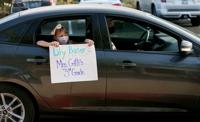
Lily Baser, 8, identifies herself for easy remote learning tool kit pickup during a "Mustang Stampede" at Manzanita Elementary School for the first day of school on August 17, 2020.
"Mustang Stampede"
Updated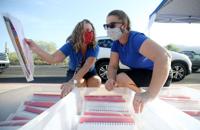
Krista Westmoreland, left, a third grade teacher, shows the remote learning tool kit of a student to Anna Ames, music teacher, during the "Mustang Stampede" at Manzanita Elementary School for the first day of school on August 17, 2020.
"Mustang Stampede"
Updated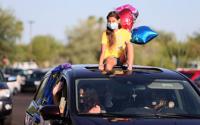
Maya Brown, 9, rides in style for her remote learning tool kit pickup during a "Mustang Stampede" at Manzanita Elementary School for the first day of school on August 17, 2020.
"Mustang Stampede"
Updated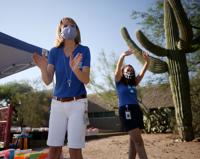
Multiage teachers Kris Green left, and April Pollow greet and cheer on their students during a "Mustang Stampede" at Manzanita Elementary School for the first day of school on August 17, 2020.
"Mustang Stampede"
Updated
Maddy Jacobs, 7, left, waves to her teacher as she stands in the sunroof with her friend, Carly Kupinski, 6, during a "Mustang Stampede" to pickup their remote learning tool kit at Manzanita Elementary School for the first day of school on August 17, 2020.
"Mustang Stampede"
Updated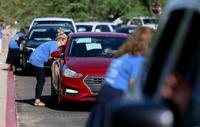
For the first day of school teachers at Manzanita Elementary School greeted their students during a "Mustang Stampede" and handed out remote learning tool kits on August 17, 2020.
"Mustang Stampede"
Updated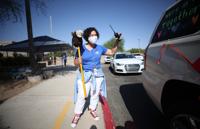
Kim Boling, principal at Manzanita Elementary School, greets her students and parents with a mustang during the "Mustang Stampede" for the first day of school on August 17, 2020.
First Day of School, John B. Wright Elementary
Updated
Yarani Martinez gives a monitor a thumbs up to inform the monitor that his online class is working after classes began at John B. Wright Elementary School, 4311 E. Linden St., in Tucson, Ariz. on August 17, 2020. About 10 students came to school for online instruction under the guidance of classroom monitors.
First Day of School, John B. Wright Elementary
Updated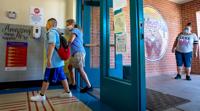
Alice Flores, right, watches as her grandson Jesus Silva is escorted to the cafeteria before classes began at John B. Wright Elementary School, 4311 E. Linden St., in Tucson, Ariz. on August 17, 2020. About 10 students came to school for online instruction under the guidance of classroom monitors.
First Day of School, John B. Wright Elementary
Updated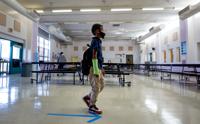
Augusta Iranzi follows the directions on the floor while being escorted to a classroom at John B. Wright Elementary School, 4311 E. Linden St., in Tucson, Ariz. on August 17, 2020. About 10 students came to school for online instruction under the guidance of classroom monitors.



